4.6 90-degree audio phase shift
By this stage the I and Q outputs are each double-sideband, and we need to process them
to demodulate single sideband.
The circuit used here is an active two-path all-pass phase shift network based on four
operational amplifiers. The circuit is based on the same phase shift block as the Norcal
NC2030 http://www.norcalqrp.org/nc2030.htm
In the real world, nothing is perfect – there are component tolerances to think about. The
unwanted sideband suppression is maximized when the amplitude of the two paths is
equal, and the 90-degree phase shift is accurate.
To improve the accuracy of the 90-degree phase shift, R17 and R24 allow adjustment of
the phase shift at higher and lower audio frequencies respectively.
R27 allows adjustment of the balance between the I and Q channels, to equalize the
amplitude from each path.
This CW transceiver kit includes built in alignment and test equipment, with a signal
generator that can inject a test signal into the receiver input. It makes it easy to perform
these adjustments, as described previously.
Note the 2-pin header pads JP9, JP10 and JP11 at the output combination potentiometer
which allow experimental modifications or connections.
4.7 CW filter
The CW filter used in this receiver has a 200Hz bandwidth. The circuit is based on the HI-
PER-MITE CW filter kit design by David Cripe NM0S, available from the Four State QRP
group: http://www.4sqrp.com/HiPerMite.php (thanks David for permission to use it here).
This is a high performance circuit specifically designed to avoid objectionable ringing.
85
